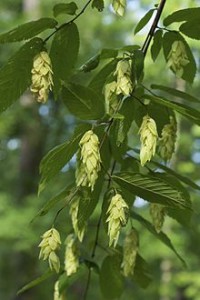
People generally ignore trees. This is because most of the time trees quietly present us with gifts like shade, cleaner air, erosion protection and beauty while asking little in return. On the rare occasions when trees break the surface of our consciousness, we generally criticize them for shedding branches in storms, dropping leaves and/or litter in autumn, or otherwise interrupting our lives. If trees thought like humans, they would complain about being unappreciated.
Sometimes though, some feature of one tree or another makes people take notice. This is the case of Ostrya virginiana, better known as American hophornbeam. In the last month or so, at least three different people have pointed to a hophornbeam and said, “What is that tree with the hops hanging from it?”
The tree in question is a member of the birch family and the pale green “hops” that hang from the branches are actually membranes that encase the tree’s nutlike fruits. The “hops” of hophornbeam only look like the bitter-tasting flowers of the Humulus lupulous, or hop vine. Unlike true hops, hophornbeam fruits are useless for beer making.
Which does not mean that hophornbeam is a useless plant. The fruiting structues that give it such an interesting appearance in the late summer contribute to its value as a small to mid-size ornamental tree. Tree guru Dr. Michael Dirr goes so far as to say, “Ostrya virginiana is an attractive, small to medium-sized tree that the American nursery industry has never pursued.”
Traditionally, hophornbeam, which is native to the eastern half of the United States, is one of a number of tree species grouped under the nickname “ironwood”. Its dense timber may not be metallic, but it is hard enough to be harvested for use in implements like mallets, tool handles and fenceposts. Unfortunately, we make fewer of those implements these days and often fabricate them from plastic or other non-wood materials. This leaves hophornbeam back where it started, as an ornamental.
And that is a very good thing. As municipalities search for tree genera and species to use as street trees, they favor less common species that can add biodiversity to streetscapes and prevent the massive deforestation that took place during the early twentieth century chestnut blight and the mid twentieth century elm die-off. Hophornbeam is well-suited to this application.
The trees are moderate in size, rising between 25 and 40 feet, with a spread that is about two thirds of the height. The ribbed green leaves remind me a little of the toothed, ovoid foliage of elm trees. They turn yellow in the fall, but are not particularly showy. Hophornbeams also bear recognizable gray to reddish-brown bark that grows in loose-ended strips, appearing ready to exfoliate.
The kinship to other birch family members is most obvious in the spring, when hophornbeams bear dangling male catkins in groups of three. Since the trees are monoecious, with flowers of both sexes on the same plant, they also produce the insignificant female flowers that morph into the distinctive “hops” as the growing season progresses. The nuts concealed in the “hops” also serve as food to a variety of wildlife. If you are into habitat gardening, this should make hophornbeam even more attractive as a street or specimen tree.
More than one source alleges that hophornbeam thrives on neglect. This is true as long as the trees are planted in full sun or very light shade. While ironwoods do not like wet soil, they are wild about hilly or dry sights and shrug at marauding deer. As street trees, they tolerate the various stresses, including vibration and pollution, which trouble other species.
My town, which has made a serious effort at replenishing its stock of street trees, has planted hophornbeam in various places. I hope this is a trend. I could happily go a long time without seeing another Norway maple, but I could drink a toast to the installation of more “hop” trees.
